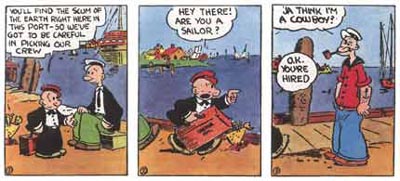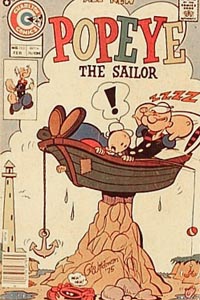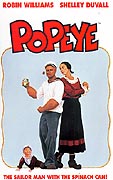|
Popeye
the Sailor Man, Comics' First Super Hero
(originally published in the Summer
1991 issue of Once Upon A Dime)
Ask a group of comics fans who the first super
powered hero in comics was and you won’t hear
Superman. You might hear Popeye the Sailor Man.
While he lacked an identity concealing costume,
he did (by eating spinach) undergo Captain Marvel-like
or Hour Man-like transformations to a far more powerful,
indeed superpowerful, version of himself.
Popeye is one of the greatest comic strip characters
of all time. Since his creation in 1929, the character
has become a comic strip and cartoon icon. Who among
us doesn't know the "Popeye the sailor man"
song or recognize Popeye's distinctive laugh? Popeye’s
enduring popularity is especially amazing since
he was initially intended by Segar as a throwaway
character.

The comic strip we know today as Popeye was originally
called Thimble Theatre. First conceived by cartoonist
E.C. Segar as a burlesque of stage melodrama when
created in 1919, Thimble Theatre evolved into a
madcap rambling humor-action serial by the late
1920s, featuring the adventures of Olive Oyl and
her family.
Plotlines frequently revolved around the schemes
of Olive's brother Castor to get rich quick. In
the 1929 sequence that introduces Popeye, in fact,
Castor has inherited the rare and unique whiffle
hen, a hen that has the ability to grant good luck
to anybody who rubs the three hairs on her head.
Castor, as you might expect, decides to try his
luck in a gambling casino with the hen. To get to
the casino, they hire a ship which happens to be
manned by a certain squinty-eyed sailor man named
Popeye.
Segar had intended on writing Popeye out of the
strip at the end of the whiffle hen adventure. However,
Segar and his syndicate were so inundated by letters
from fans who loved the character, they quickly
decided to keep Popeye in Thimble Theatre.
Popeye was a sensation that immediately captured
the attention of comic strip readers. When he first
appeared in the strip, Thimble Theatre appeared
in only a half-dozen newspapers. By 1933, Popeye
had become a national icon, appearing in cartoons
as well as innumerable pieces of merchandising ranging
from tin figurines to napkin rings to pencils with
Popeye's face on them.
Something about the sailor struck gold in the early
days of the Depression. Perhaps it was his personality
that people loved so much. In a world where unemployment
was an epidemic and poverty pervasive, it was easy
to despair. But Popeye was a positive character,
a man whose physical abilities and charisma would
carry him through any crisis.
He is sometimes called the first super-hero due
to his great strength (even without spinach!), but
he was also a super-hero due to his unflagging joy
and passion in life. No matter how much he was in
peril due to the schemes of the Sea Hag or any of
his other antagonists, Popeye would always triumph.
Popeye thought with his fists. He never minded
a scrape. Heck, like any good sailor man, he loved
a good fight! Popeye frequently got involved in
boxing matches, fights he would always win even
though his opponent was invariably twice his size.
The Sailor Man also thought with his heart. His
love for Olive Oyl was as deep and passionate as
any love in comics, topped only by his love for
his adopted son Swee'pea.
Under Segar, Popeye was a great hero with a heart
of gold. He represented America's view of itself
during the Depression: no matter how tough the odds,
American passion and fighting spirit would triumph.
 Most
of us who grew up in the 1960s and 70s know Popeye
from the cartoons he starred in that were made between
the 1930s and 1970s. In 1980, a full-length live
action Popeye movie was released. I recently decided
it would be fun to go back and re-watch the movie.
I have distinct memories of driving home from the
movie with my friend Paul, who I called Andre for
reasons that escape me now. I remember Andre and
me raving about the movie and singing the rousing
song that opens the movie. “Sweet… Sweethaven.
God must love us,” the song went. I remembered
that song for years, and before I popped in the
movie I found myself humming the tune in anticipation
of the wonderful time I was expecting to have. Most
of us who grew up in the 1960s and 70s know Popeye
from the cartoons he starred in that were made between
the 1930s and 1970s. In 1980, a full-length live
action Popeye movie was released. I recently decided
it would be fun to go back and re-watch the movie.
I have distinct memories of driving home from the
movie with my friend Paul, who I called Andre for
reasons that escape me now. I remember Andre and
me raving about the movie and singing the rousing
song that opens the movie. “Sweet… Sweethaven.
God must love us,” the song went. I remembered
that song for years, and before I popped in the
movie I found myself humming the tune in anticipation
of the wonderful time I was expecting to have.
The first few minutes of the movie are indeed wonderful.
It starts with a short excerpt from the old Fleisher
black-and-white Popeye cartoons – a nice touch
of nostalgia – and quickly switches to a shot
of Robin Williams, as Popeye, arriving in the ramshackle
fishing village of Sweethaven. His arrival is greeted
with the very song I remember so nostalgically,
and it is indeed a rousing song, a perfect curtain-raiser.
The tune introduces the viewer to the amazing set
of the town of Sweethaven and to the bizarre citizens
of the town. We see cute shtick and hear a charming
song, and the audience is expecting the whole movie
to drift along on a cloud of whimsy and charm.
Instead, after the song ends we get a cute scene
that involves Popeye paying a series of absurd taxes
that seems to be directly out of the E.C. Segar
comic strip that inspired the movie. Once Popeye
pays his taxes, though, the movie suddenly dies.
He wanders through the village to find a boarding
house and he starts mumbling a tune under his breath.
The mumbling in the old black-and-white cartoons
would only fill space between action scenes, but
in this movie, the mumbling threatens to overwhelm
anything else in the film. I kept expecting the
mumbled song to suddenly explode into another production
number; instead, Popeye keeps mumbling the song
for a good two or three minutes, and I just strained
to make out what he was singing.
And right there the movie loses its momentum, in
a moment that is emblematic of the whole movie:
over and over again, there’s a charming or
fun scene followed by one that makes no sense and
deflates the audience’s goodwill. By the end
of the movie and its notoriously awful ending, I
lost my attention span and found myself looking
around for a book to read rather than watch the
movie.
 I’m
sorry to say it, but in my opinion, the movie Popeye
is an absolute mess. It was the product of a number
of decisions that, taken independently, probably
made sense. But cumulatively, the decisions produced
a train wreck. I’m
sorry to say it, but in my opinion, the movie Popeye
is an absolute mess. It was the product of a number
of decisions that, taken independently, probably
made sense. But cumulatively, the decisions produced
a train wreck.
Popeye was surely produced due to the runaway success
of the Broadway musical Annie, which was based on
the famous 1930s comic strip Little Orphan Annie.
What girl who grew up in the late 1970s and early
‘80s didn’t know the words to Annie’s
heartwarming song “Tomorrow”? However,
it took many years for Annie to make it to the big
screen. For the summer of 1980, the studios wanted
an Annie-style blockbuster. What character would
have even better name recognition than Popeye? The
comic strip was appearing in hundreds of newspapers
around the world, and the Popeye cartoons were running
every day in syndication in nearly every city around
the country. Robert Evans, producer of such classics
as Chinatown, Marathon Man and Urban Cowboy would
produce the film, and Robin Williams, then a hot
star of Mork and Mindy, would star.
The big mistake made with this film was in assigning
the direction of it to Robert Altman. Although I
think he’s one of the finest directors of
the 1970s, Altman was uniquely ill-suited for this
movie. Popeye was based on a popular comic strip.
Comic strips demand clear, bold and internally plausible
plots in order to work well. However, Altman’s
gift was in creating movies in which the plots and
motivations of characters were deliberately muddy.
In films like M*A*S*H, McCabe and Mrs. Miller, The
Long Goodbye and Nashville, the plots don’t
follow a sequential line as much as they seem to
ooze off the screen. His characters are always motivated
by their own interests, to almost seem smaller than
life in their views of the world.
If Popeye was going to be true to the comic, Altman
would have to ignore the impulses that brought us
ambiguous antiheroes like Hawkeye Pierce, his very
strange version of Philip Marlowe and his alcoholic
Buffalo Bill. They were a far cry from bold Popeye,
whose whole world view could be summed up with the
motto “I yam what I yam.” Basically
everything that Robert Altman does well - create
a world and allow skilled actors to bring it alive
through improvisation and subtle editing - works
against the movie. Where the movie should have a
clear internal logic, like the comic, it instead
meanders all over the place
So, faced with presenting a film that was in dramatic
contrast with his type of film, Altman ended up
releasing a film in which he seemed to make a halfhearted
attempt at a summer blockbuster. It looks great
– reportedly the set of the mythical city
of Sweethaven took nine months to create in the
remote island of Malta – but the plot makes
little or no sense and the style of the film is
all wrong for its subject matter. What should be
bright and colorful and fun just ends up mainly
being muddled, weird and hard to understand.
I desperately wanted to enjoy the movie of Popeye.
I had great memories of it, I love Altman, and a
couple of the songs are wonderful. But the truth
is that by the end I found it almost impossible
to watch.
It's not worth the effort to seek out the movie,
but it's definitely worth the effort to seek out
reprints of E.C. Segar's original comic strip. The
strips are so charming and inventive, and the character
so wonderful, that it's impossible to resist.
--
Jason Sacks
|